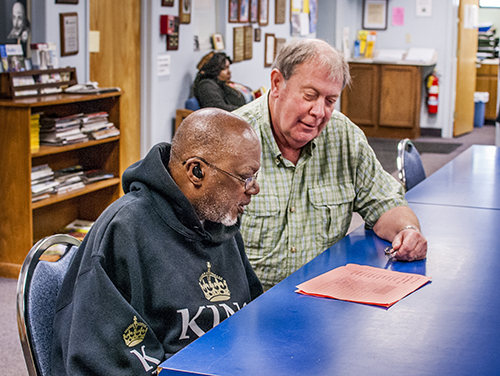
Darryl Townsend, left, passed his GED test with help from tutor Peter Barclay at Common Place, but Townsend explains why the courthouse is a problematic location for the test. (PHOTO BY CLARE HOWARD)
Darryl Townsend felt a strange sense of alarm as he walked into the Peoria County Courthouse, through security, past armed guards.
He was there for his GED test, but it was not test anxiety he was experiencing. It was knowledge about how the system works.
Townsend, 59, has a good record – an excellent record: three years with the U.S. Navy, decades working at Mitsubishi Motors until arthritis became disabling, eight children who graduated from high school and went on the college.
But Townsend once missed a court date for a minor traffic violation in another county. Unbeknownst to him, an arrest warrant was issued. A long time later, he was in the courthouse on routine business when the outstanding warrant was discovered. He was detained and arrested. His kids had to come and bond him out.
It was the memory of that experience that swept over him as he walked toward the elevators in the Peoria County Courthouse to get to the testing room on the fourth floor.
“Your mind starts wondering. Could there be another missed court date or another warrant? Might there be a mistake out there?” Townsend said recently. “The courthouse is not a comfortable place.”
Peter Barclay, one of Townsend’s GED tutors at Common Place, said when he tells students they have to go to the courthouse for the GED test, he can see they are taken aback even though he reassures people the GED test administrators don’t check for outstanding warrants.
“It’s another obstacle to overcome, another hurdle thrown in their path. You don’t know what could happen. They don’t know if they might have an outstanding ticket they never knew about,” Barclay said.
Patricia Moten, adult literacy director at Common Place, said, “The courthouse is always equated with something negative. It doesn’t matter if the warrant was for jaywalking or murder. The clerk will say, ‘Hold on a second.’ You are there to pay a ticket. You missed by one day. That’s all it takes.”
The Peoria County Courthouse is the only designated test site for GED tests in the county. Peoria County Regional Superintendent of Education Beth Crider would like to change that.
She is working with Peoria County to secure a new location outside the courthouse.
“We have to work with everyone, not just K-12 children but a multitude of adults as well,” Crider said. “We don’t need security. Going through security puts a barrier between us and the people we serve.”
She said the adult learners entering the courthouse for the GED test “are already carrying the baggage of past failures. ‘I failed. I dropped out.’ Those emotions are already reverberating in their heads.”
Passing the GED test is a transformative process.
“Getting a high school diploma or a GED leads to a sustainable wage. They can move on to stackable credentials like a CNA earning $19 an hour,” Crider said.
Moten added, “ We want our clients to feel comfortable, to get past the barriers and to connect with the GED testing site. If we want our community to move forward, we have to remove the barriers. What was set up in the past, does not need to be how the system operates today.”
Stakeholders need a voice in how the system works.
Barclay said, “Fear of the courthouse is not something I thought of. It’s not something my children think of, but it is something I hear from the GED students.”
Crider would like to consolidate her offices that are now spread out over several locations. She has looked at the building the Peoria County Election Commission now occupies at 4422 Brandywine Drive. (The Election Commission moved from the old police station at 542 SW Adams St. in September.)
She is currently paying $50,000 a year for rent for her satellite location in Edwards. Consolidating and moving into a county-owned building could save that money.
But the bottom line is focusing on the clients her office serves with the GED test, she said.
“No one is forced to go back as an adult and get a GED. These are motivated learners. They have intestinal fortitude, and they plow through the process,” Crider said. “They don’t need to go through security. Going through security is one more barrier to the test site. If anyone is willing to take the plunge –– to take this on to make their life better –– we are here to support them.”
Perceiving barriers, both covert and overt, is one task for Dr. Farris Muhammad, Peoria’s new chief diversity and inclusion officer.
“We need a holistic understanding in order to make the city better. All voices have to be heard,” he said.
It is not sufficient for one group to make assumptions about access or lack of access confronting another segment of the population.
“By analogy, if I step on your foot, it is not up to me to tell you how much pain you’re feeling,” Muhammad said.
With physical disabilities, barriers can be seen, defined and resolved but with barriers of race or poverty, barriers are often not perceived except by those being discriminated against. Their voices must be heard in order to define and resolve the problem, Muhammad said.
“When a problem is clearly defined, it’s half way to being solved,” he said, noting that addressing cultural inequality often follows a pattern: denial, defensiveness, minimization, then acceptance, understanding, adaptations and ultimately integration of differences.
The terrible ranking Peoria received in the 24/7 Wall Street Report as the worst city for Blacks in America is negative for the entire city, not just one segment of the city.
“If we want the city to thrive, we have to make sure the whole city thrives,” Muhammad said.

Recent Comments